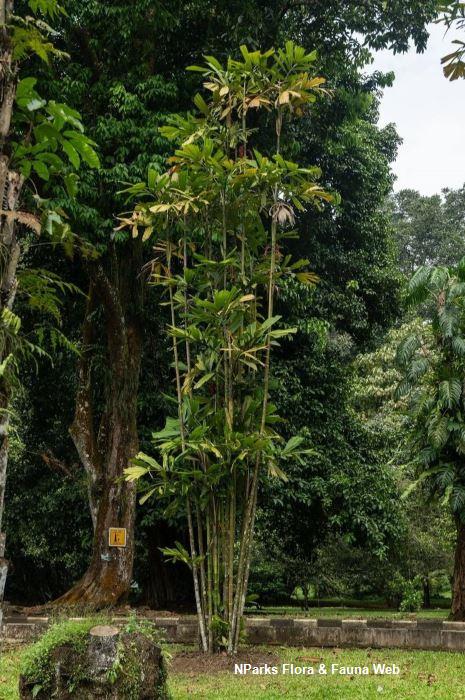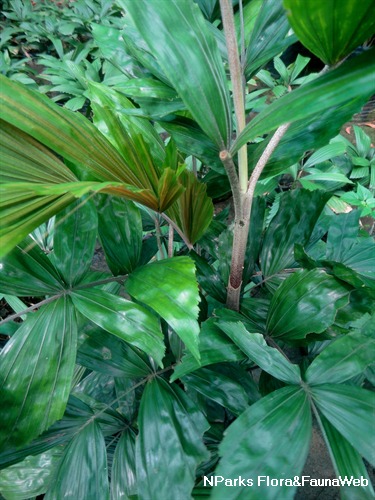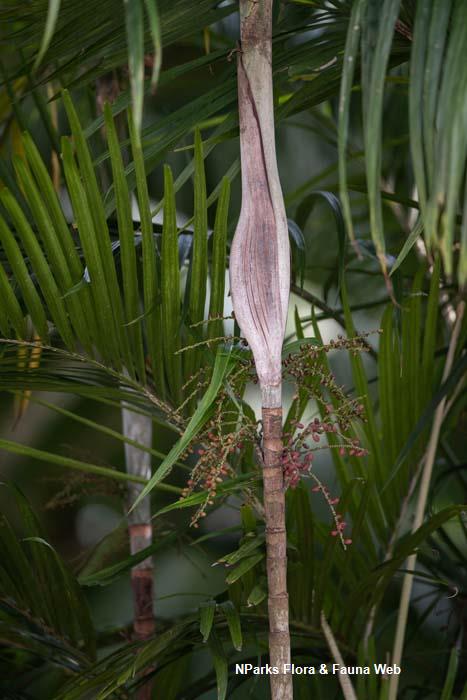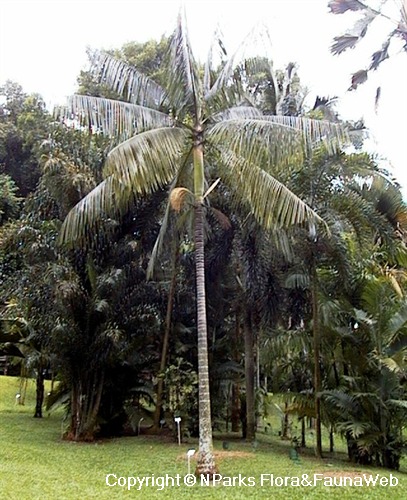
Back
Hydriastele pinangoides (Becc.) W.J.Baker & Loo
| Family Name: | Arecaceae (Palmae) |
| Synonyms: | Nengella pinangoides Becc., Nenga pinangoides Becc., Gronophyllum micranthum (Burret) Essig & B.E.Young, Gronophyllum pinangoides (Becc.) Essig & B.E.Young, Leptophoenix macrocarpa Burret. |
Hydriastele pinangoides is a slender, understorey palm with a solitary or clustering habit. Reaching 7 - 10 m in height, it is endemic to New Guinea. The palm has 5 - 10 pinnately compound fronds per crown, each bearing 2 - 3 irregular clusters of wedge-shaped leaflets.
Name
Classifications and Characteristics
| Plant Division | Angiosperms (Flowering Seed Plants) (Monocotyledon) |
|---|---|
| Plant Growth Form | Palm (Solitary Habit, Clustered Habit) |
| Lifespan (in Singapore) | Perennial |
| Mode of Nutrition | Autotrophic |
| Plant Shape | Fountain (Palm-like) |
| Maximum Height | 7 m to 10 m |
Biogeography
| Native Distribution | New Guinea |
|---|---|
| Native Habitat | Terrestrial (Primary Rainforest) |
| Preferred Climate Zone | Tropical, Highland / Montane |
| Local Conservation Status | Non-native (Horticultural / Cultivated Only) |
Description and Ethnobotany
| Growth Form | It is a slender, solitary or clustering palm, up to 7 - 10 m tall. |
|---|---|
| Foliage | The fronds are dark green and even-pinnately compound, up to 0.5 - 1.57 m long, including the petiole. There are 5 - 10 (-13) wedge-shaped leaflets with jagged edges on each side of the rachis; they are variable in size and shape and irregularly arranged in 2 or 3 widely spaced groups—rarely are the leaflets evenly arranged. The petiole is 15 - 54 cm long. The new fronds are red or bronze. Fronds on seedlings are bilobed and undivided. |
| Stems | The stems are slender, up to 1.5 - 7.5 cm in diameter. Each stem bears 5 - 10 fronds. |
| Crown Shaft | The crown shaft is 15 - 52 cm long, and green or covered in waxy bloom. |
| Flowers | The inflorescence is infrafoliar, emerging below the fronds and crown shaft, and subtended by a spathe or peduncular bract. It is (13-)18 - 30 cm long, including a 1.5 - 3 cm peduncle (central stalk on inflorescence) and branches up to 1 order with 2 - 5 (-6) arching, pink rachillae (minor, secondary axes on inflorescences). Triads of one female flower flanked by two male flowers are arranged spirally throughout each rachillae. The reddish male flowers are larger than female flowers, with 6 stamens. Female flowers have pink to reddish free sepals and petals with conspicuous triangular tips. |
| Fruit | The fruit are ellipsoid or cylindrical to spindle-shaped drupes, up to 10 - 16 mm long and 4 - 8 mm wide. They ripen to pink, red, purple or blackish. The single seed is ellipsoid, up to 6- 10 mm long and 2 - 4 mm wide. |
| Habitat | It can be found in lowland to montane rainforest from 0 - 1350 m above sea level. |
| Similar | This variable species can be confused with H. divaricata and H. simbiakii when certain specimens produce regularly arranged and narrowly wedge-shaped leaflets; To differentiate, H. divaricata has divaricate leaflets and inflorescences with 1 - 2 rachillae, while H. simbiakii has flexible, usually leaning stems and 14 - 16 pairs of leaflets on a frond. H. pinangoides can also be confused with some pinnate-leaved forms of H. flabellata, although the latter tends to have a shorter, spicate or bifid inflorescence. |
| Cultivation | It does well in moist, well-drained, loamy soil and shaded or partially shaded conditions. Older and taller plants can tolerate full sun conditions. It can be propagated by seeds. |
| Etymology | The genus Hydriastele is derived from Greek either hydría, "water pot", hydor "water" or hydrias, "water nymph", and stḗlē, "pillar, column", possibly referring to the erect slender stems of some of the species growing near water. The specific epithet pinangoides means "Pinanga-like", referring to its resemblance to the genus Pinanga. |
| Ethnobotanical Uses | Edible Plant Parts : Edible Leaves Timber & Products: The stems are used for spears and spearheads in Papua New Guinea, as well as for arrowheads, sewing thatch, and as bow material in the Papua province of western New Guinea. The fronds are used for roofing in Papua province. Cultural / Religious: The palm has been used for magic in Papua province of western New Guinea. Others: The young shoots (heart of palm) are edible. |
Landscaping Features
| Desirable Plant Features | Ornamental Foliage |
|---|---|
| Landscape Uses | Parks & Gardens |
Plant Care and Propagation
| Light Preference | Semi-Shade |
|---|---|
| Water Preference | Moderate Water, [Remarks] (Do not let the soil dry out between waterings.) |
| Plant Growth Rate | Moderate |
| Rootzone Tolerance | Moist Soils, Well-Drained Soils, Fertile Loamy Soils |
Foliar
| Foliage Retention | Evergreen |
|---|---|
| Mature Foliage Colour(s) | Green |
| Mature Foliage Texture(s) | Papery |
| Prominent Young Flush Colour(s) | Red, Orange |
| Foliar Type | Compound (Even-Pinnate) |
| Foliar Arrangement Along Stem | Spiral |
| Foliar Attachment to Stem | Petiolate |
| Foliar Shape(s) | Palm Fronds (Pinnate / Feather) |
| Foliar Venation | Parallel |
| Foliar Margin | Doubly Serrate |
| Foliar Base | Cuneate |
| Leaf Area Index (LAI) for Green Plot Ratio | 4.0 (Palm - Cluster) |
Non - Foliar and Storage
| Trunk Type (Palm) | Aboveground, Solitary Habit, Clustering Habit |
|---|---|
| Root Type | Underground (Fibrous Root) |
Floral (Angiosperm)
| Flower & Plant Sexuality | Unisexual Flowers , Monoecious |
| Flower Colour(s) | Purple, Red |
|---|
| Flower Grouping | Cluster / Inflorescence |
| Flower Location | Axillary |
| Flower Symmetry | Asymmetrical |
| Inflorescence Type | Spikelet / Pseudospikelet / Compound Spike |
| Ovary Position | Superior / Hypogynous |
| Flowering Habit | Polycarpic |
Fruit, Seed and Spore
| Mature Fruit Colour(s) | Pink, Purple, Red, Black |
|---|---|
| Fruit Classification | Simple Fruit |
| Fruit Type | Fleshy Fruit , Drupe |
| Seed Quantity Per Fruit | Few (1-5) |
References
| References | Baker, W.J., Barfod, A.S., Cámara-Leret, R., Dowe, J.L., Heatubun, C.D., Petoe, P., Turner, J.H., Zona, S. & Dransfield, J. (2024) Palms of New Guinea. Royal Botanic Gardens, Kew, Richmond. 529-535. Heatubun, C.D., Petoe, P., & Baker, W.J. (2018). A monograph of the Nengella group of Hydriastele (Arecaceae). Kew Bulletin 73:18. 1-22. |
|---|
Image Repository
Others
| Master ID | 32549 |
|---|---|
| Species ID | 6961 |
| Flora Disclaimer | The information in this website has been compiled from reliable sources, such as reference works on medicinal plants. It is not a substitute for medical advice or treatment and NParks does not purport to provide any medical advice. Readers should always consult his/her physician before using or consuming a plant for medicinal purposes. |







_lowres.jpg)


